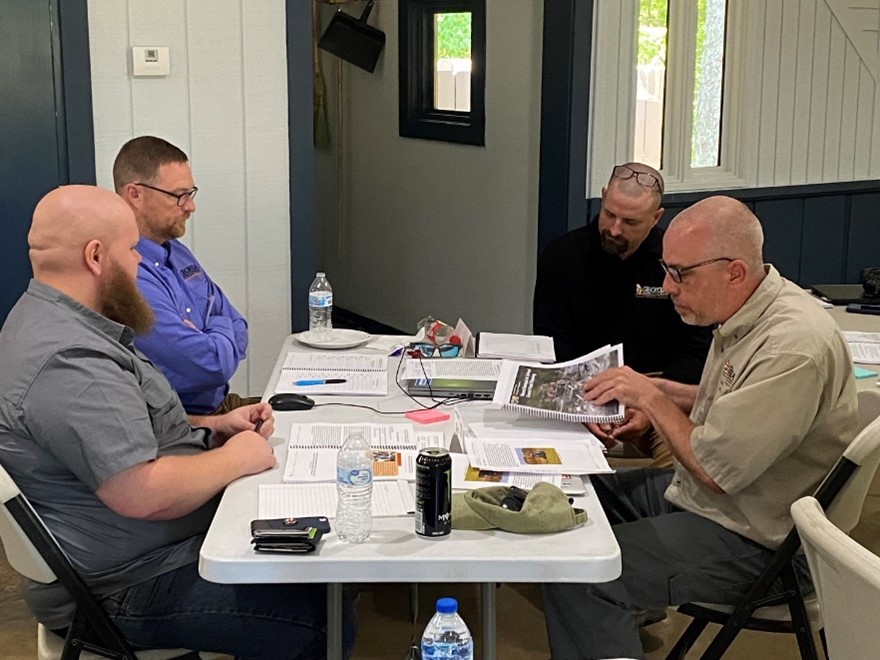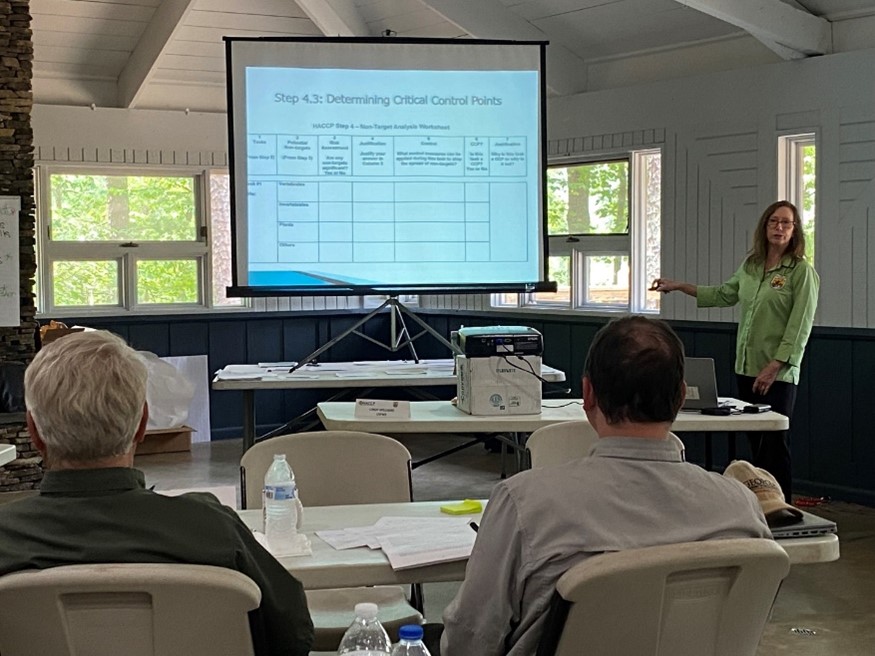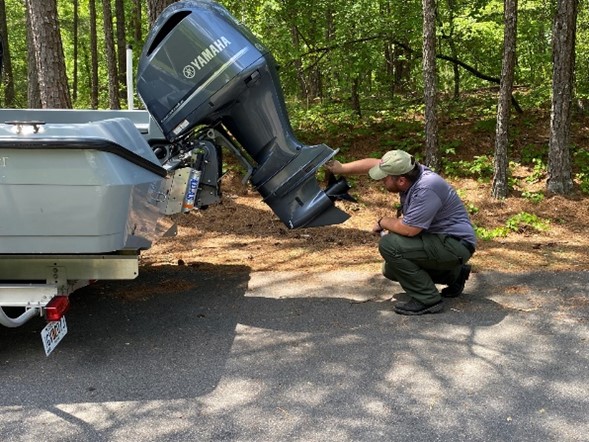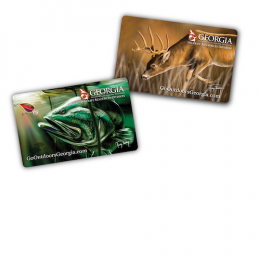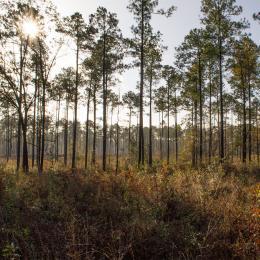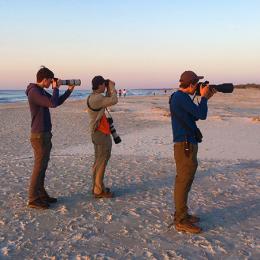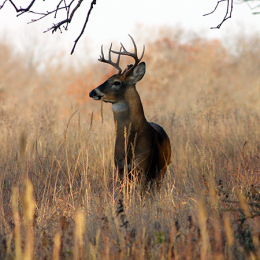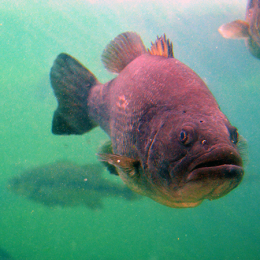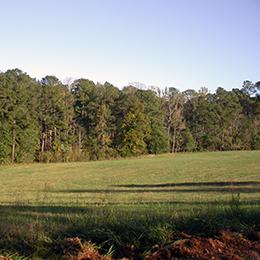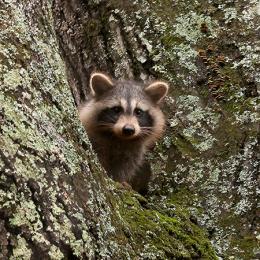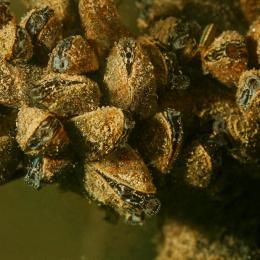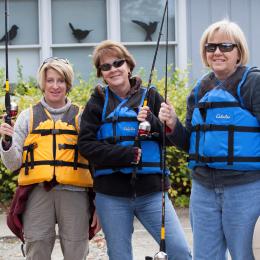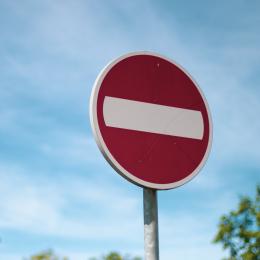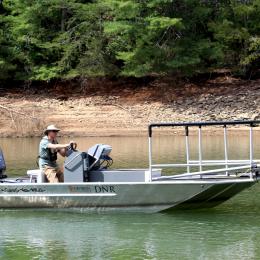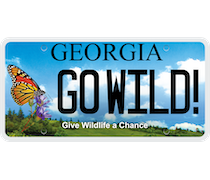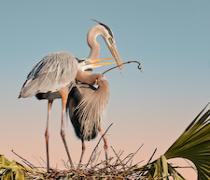Like many other states, Georgia has experienced Aquatic Nuisance Species (ANS) introductions. Many of these introduced species have affected or have the potential to negatively impact Georgia native species. Though some of these introductions are the result of range expansions or climatic events (e.g., hurricanes, etc.), most are the result of human activities. To properly respond and formulate appropriate monitoring/management strategies, the Georgia Department of Natural Resources’ Wildlife Resources Division (GA WRD) oversees the management of and response to several ANS that occur in this state.
Remember: Moving live fish, aquatic plants, or mussels from one body of water to another can cause irreversible damage to the existing ecological balance of Georgia lakes, rivers, and streams. Releasing unwanted aquarium species or other non-native species into a water body can have severe negative impacts on native fish and fauna.

Stop the spread of aquatic nuisance species. Non-native or introduced species can be an issue in Georgia, often presenting problems for many of our native fish and plant populations. You can help by:
- Refrain from relocating fish or aquatic plants to areas in which they are not native
- Remove any non-native species you catch while fishing
- Report any non-native species you encounter while on the water to your local DNR office
- Remember to practice clean, drain and dry after returning to the boat ramp
How To Report Non-Native Species
It is important to report non-native species- see the "ANS examples" tab below for a list. There are two methods to file a report:
- Specimen (preferred method): Remove the species from the water body and retain it (preferably alive) in a secure container and contact the regional GA WRD Fisheries Office.
- Online: Some species may be reported online. Take several photos of the species; then click on the “Report Invasive Species Link” below and select the species name. Fill out the form and submit. Be sure to include your contact information (name, phone number, email, etc.). Not sure about species identification? Contact the regional GA WRD Fisheries Office.
Report Invasive Species
Contact Your Local Fisheries
Recent News/Discoveries
 Georgia DNR staff have recently been receiving reports of a new non-native marine crab being found along the Georgia coast. The Blue Land Crab is a large land crab native from Brazil to south Florida, but recently specimens have been found in Georgia, South Carolina, and North Carolina. The species is known to frequently burrow and can attain sizes of 5-6inches. While uncertainty exist about the potential ecological and economic impacts of the species, concerns do exist about damage caused by the crabs during burrowing activities. Anyone discovering a Blue Land Crab is asked to take a picture of it and report it above.
Georgia DNR staff have recently been receiving reports of a new non-native marine crab being found along the Georgia coast. The Blue Land Crab is a large land crab native from Brazil to south Florida, but recently specimens have been found in Georgia, South Carolina, and North Carolina. The species is known to frequently burrow and can attain sizes of 5-6inches. While uncertainty exist about the potential ecological and economic impacts of the species, concerns do exist about damage caused by the crabs during burrowing activities. Anyone discovering a Blue Land Crab is asked to take a picture of it and report it above.
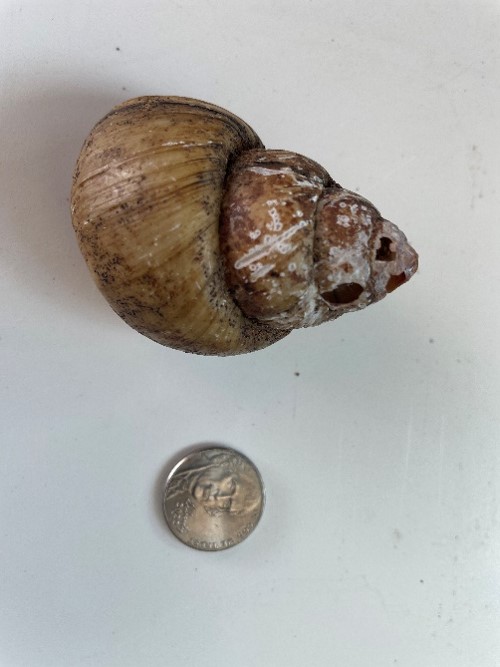 Chinese/Japanese Mystery Snails continue to be found in several waterbodies around the state. A member of the genus Cipangopaludina, Chinese/Japanese Mystery Snails have been found to cause significant ecological impacts by out-competing native snail species while also posing a threat to human health with the many intestinal parasites they may carry. While these snails have historically been popular as both a food source and aquarium pet in the U.S., recent regulatory changes prohibit individuals from possessing live mystery snails within the state of Georgia, regardless of their intended use. Anyone discovering Chinese/Japanese Mystery Snails is asked to take a picture of the snail and report it above.
Chinese/Japanese Mystery Snails continue to be found in several waterbodies around the state. A member of the genus Cipangopaludina, Chinese/Japanese Mystery Snails have been found to cause significant ecological impacts by out-competing native snail species while also posing a threat to human health with the many intestinal parasites they may carry. While these snails have historically been popular as both a food source and aquarium pet in the U.S., recent regulatory changes prohibit individuals from possessing live mystery snails within the state of Georgia, regardless of their intended use. Anyone discovering Chinese/Japanese Mystery Snails is asked to take a picture of the snail and report it above.
- ANS Examples (Found In or Near Georgia)
Fish & Animal Species
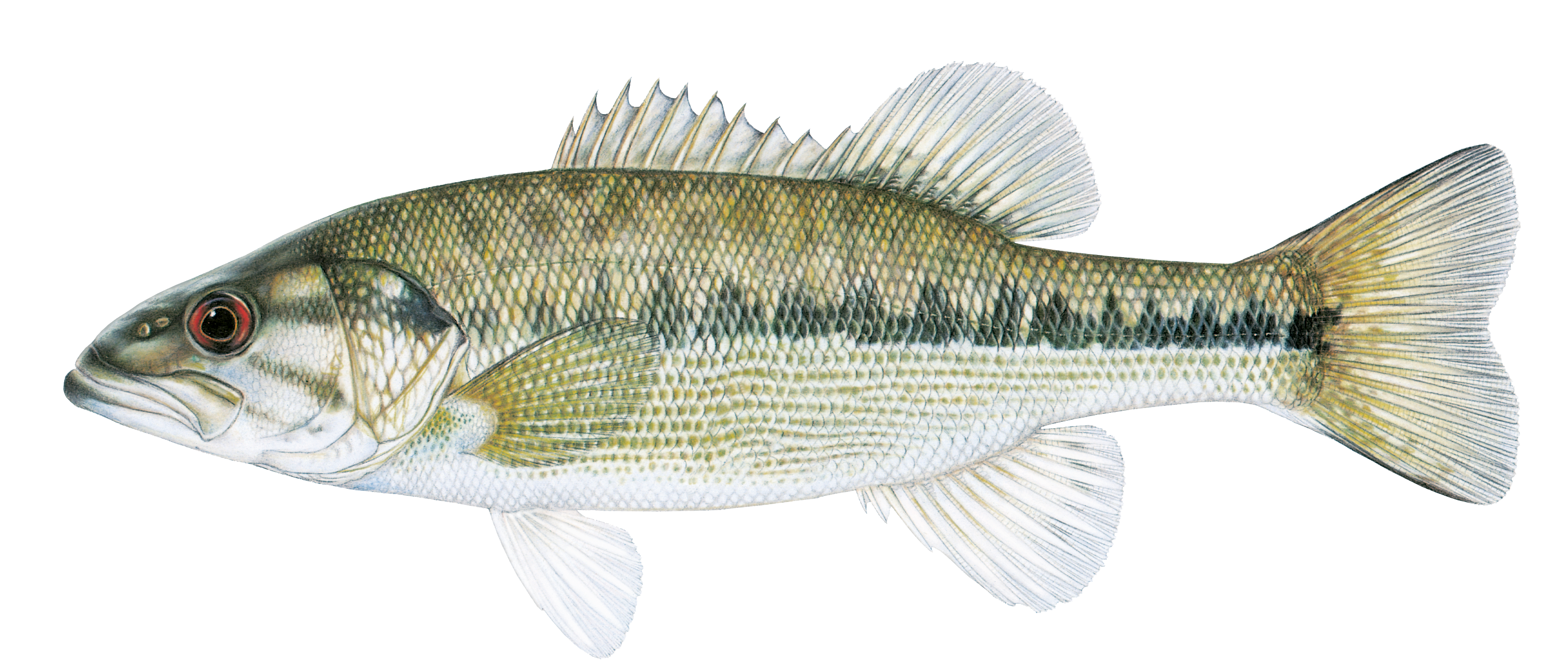 Alabama Bass (Alabama Spotted Bass)
Alabama Bass (Alabama Spotted Bass)
Alabama bass (Micropterus henshalli), better known as Alabama spotted bass, were once considered a subspecies of spotted bass, but as of 2013 are recognized as a separate species more closely related to the red-eye basses. Native to the Coosa and Tallapoosa rivers in Georgia, their popularity resulted in illegal introduction throughout many other large state waterbodies, including Lake Lanier in the early 1970’s. While the species has an ability to grow faster and larger than spotted bass, the species poses a significant concern in introduced areas and has proven to hybridize with every native species of black bass in the state except Suwannee bass. Such hybridization is problematic and compromises the genetic purity of native bass species like shoal, Chattahoochee, smallmouth, and largemouth. Largemouth populations have been affected by the species and Georgia's best smallmouth bass fishery, Lake Chatuge, was lost to illegally stocked Alabama bass. The only remaining smallmouth bass fishery, Lake Blue Ridge, is threatened by Alabama bass competition.While Alabama bass may be more aggressive and thus catchable for some fishermen, they are not native to much of Georgia and can have negative impacts on other fish species. Anglers should not relocate or introduce these species into new areas.
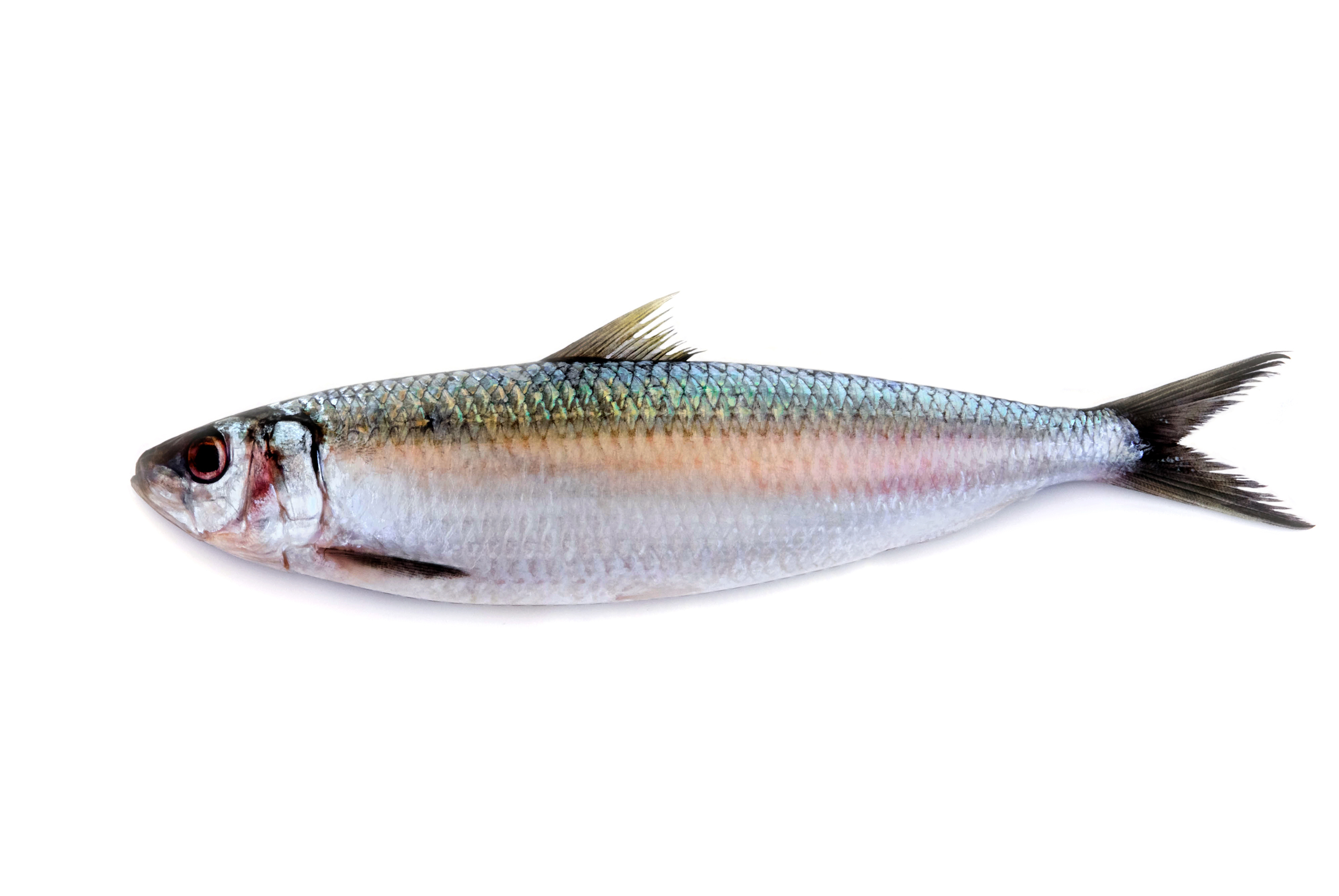 Alewife
Alewife
Native throughout much of the Atlantic coast north of Georgia, alewife (Alosa pseudoharengus) have been introduced in several inland waterbodies, including Lakes Carters and Allatoona, and the Coosa and Savannah Rivers. Similar to blueback herring (Alosa aestivalis), alewife is dorsally green and have 39-41 rakers on the lower limb of the 1st gill arch, while blueback herring have 44-50 and are blue dorsally. Like blueback herring, this voracious consumer of zooplankton can negatively impact and alter food webs, causing significant impact to native fish populations, including white bass.Asian Carp (Bighead, Silver, Black)
Imported to the U.S. in the 1970s as a means of controlling algal blooms in aquaculture ponds and wastewater treatment facilities, Asian carp (Bighead, Black, and Silver) are exotic fish species invading and causing harm to native fishes and mussels throughout the Mississippi River basin. Of these three species, the proximity of bighead carp and silver carp in states adjacent to Georgia elevates their threat level.As fast-growing filter feeders, bighead carp and silver carp can dominate a fish community, impact native species, alter water quality, and harm important commercial and recreational fisheries. Additionally, silver carp may create a significant safety hazard for boaters due to their tendency to jump when startled, with the potential to subsequently land in boats and injure occupants. Native to China and prized there for aquaculture, bighead and silver carp are now found as far south as Tennessee. Though none of these carp species have been detected in Georgia waters yet, their proximity is of serious concern. If you suspect you have captured an Asian carp, note where it was found (water body, GPS coordinates), retain it and immediately contact the regional GA WRD Fisheries Office.
Note: Grass carp are a non-native Asian carp found in private ponds throughout Georgia. These fish are stocked for the purpose of controlling unwanted aquatic vegetation. It is important to note that only sterile (triploid) grass carp are allowed to be stocked in Georgia.
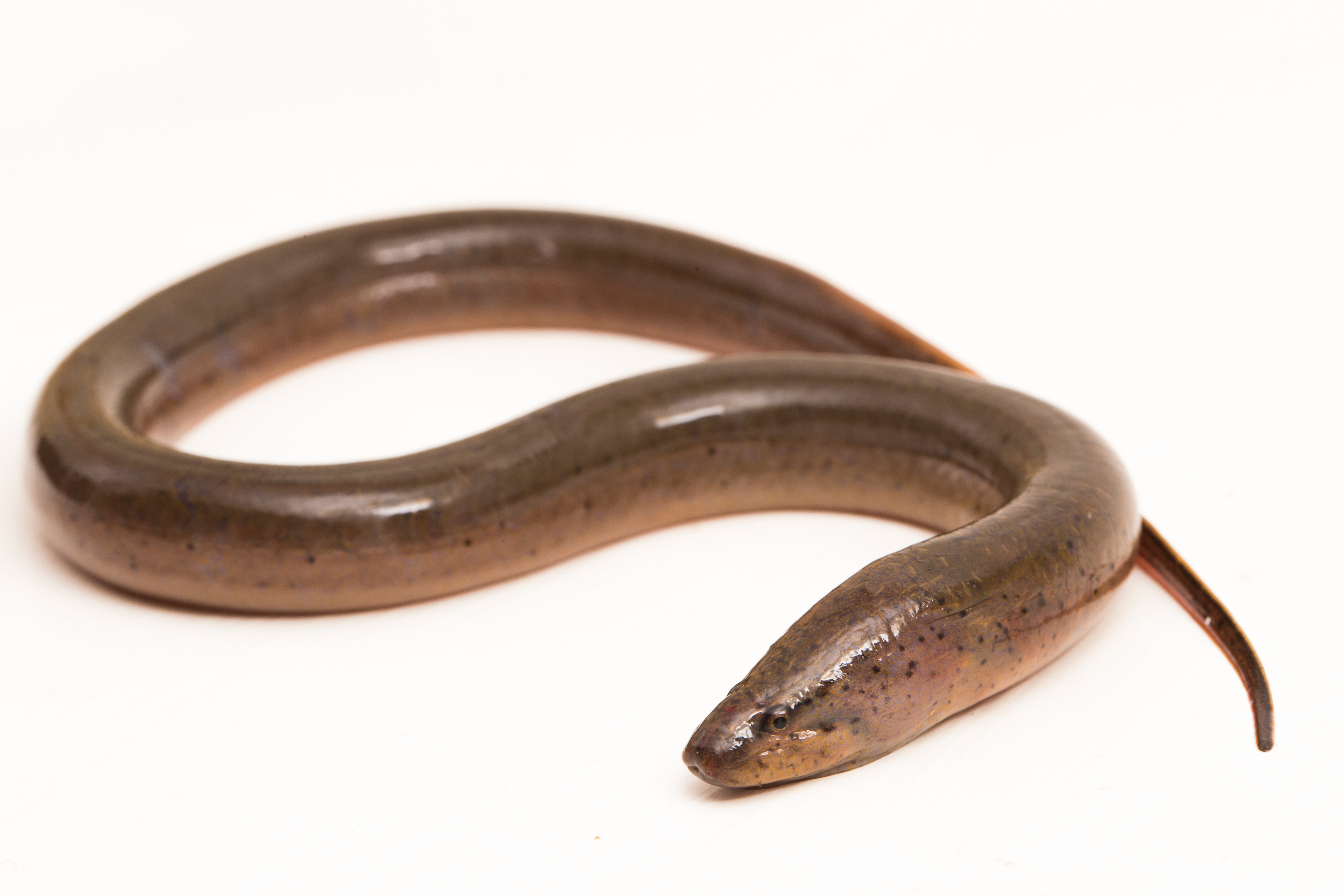 Asian Swamp Eel
Asian Swamp Eel
Found in multiple locations in Georgia but native to Asia, India, and China, the Asian swamp eel (Monopterus albus) is not a true eel. The species has a scaleless, elongated body with a tapering tail and blunt snout, unlike the native American eel (Anguilla rostrata) that has embedded scales; pectoral fins; and rayed dorsal, anal and caudal fins. The life cycle of the Asian swamp eel, which occurs entirely in freshwater, is quite interesting: all young are female at birth, with some changing into males as adults, though such males may transition back into females should female densities become low. Such strategies, along with the species ability to exists in a variety of habitats (shallow wetlands, stagnant waters, marshes, streams, rivers, ditches, canals, lakes, reservoirs, and shallow ponds); it’s tolerance of cold temperatures (can survive below freezing); and its tolerance of a wide range of water oxygen levels make it a very adaptable non-native species. The ecological impacts of Asian swamp eels remain relatively unknown, but the potential to negatively impact native species through predation or competition is concerning. Report Asian swamp eel sightings to the regional GA WRD Fisheries Office.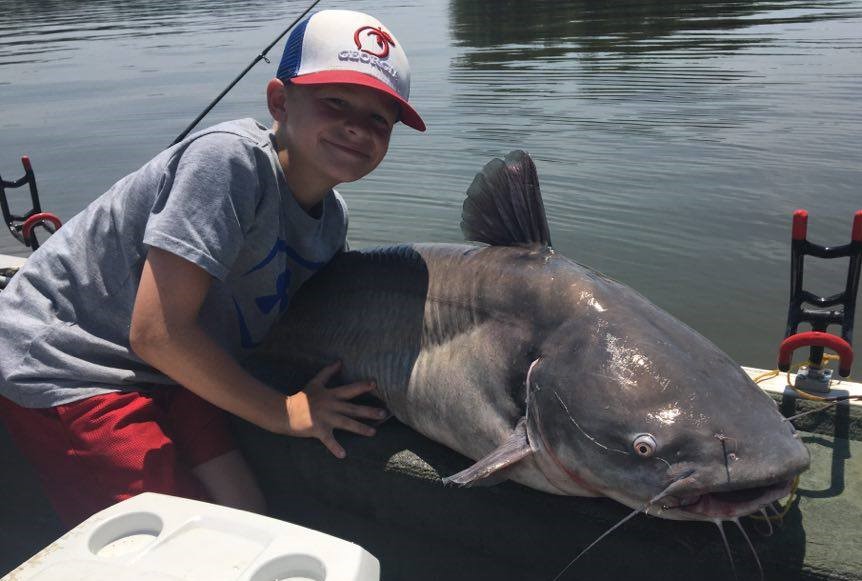 Blue Catfish
Blue Catfish
One of the largest freshwater catfish species in North America, blue catfish (Ictalurus furcatus) are native only to the Coosa River in Georgia but have been illegally introduced into several rivers, including the Ocmulgee, Oconee, Altamaha and Satilla (to name a few). Highly omnivorous, blue catfish have been found to prey on non-native Asian clam (Corbiucula fluminea) in the Satilla River (and other rivers) while also feeding on a multitude of native fish. As part of the flathead removal project on the Satilla River, GA WRD fisheries staff are also removing non-native blue catfish.Blueback Herring
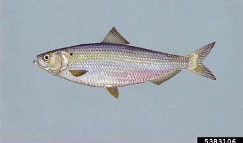
An anadromous species native along much of the Atlantic coast, including Georgia, blueback herring (Alosa aestivalis) have been introduced in several inland waterbodies. Similar to alewife (Alosa pseudoharengus), blueback herring are dorsally blue and have 44-50 rakers on the lower limb of the 1st gill arch, while alewife have 39-41 and are green dorsally. A voracious consumer of zooplankton and fish eggs/fry, blueback herring have negatively impacted sunfish (bream), largemouth bass, white bass, walleye, and crappie populations in several Georgia mountain lakes where they have been illegally introduced.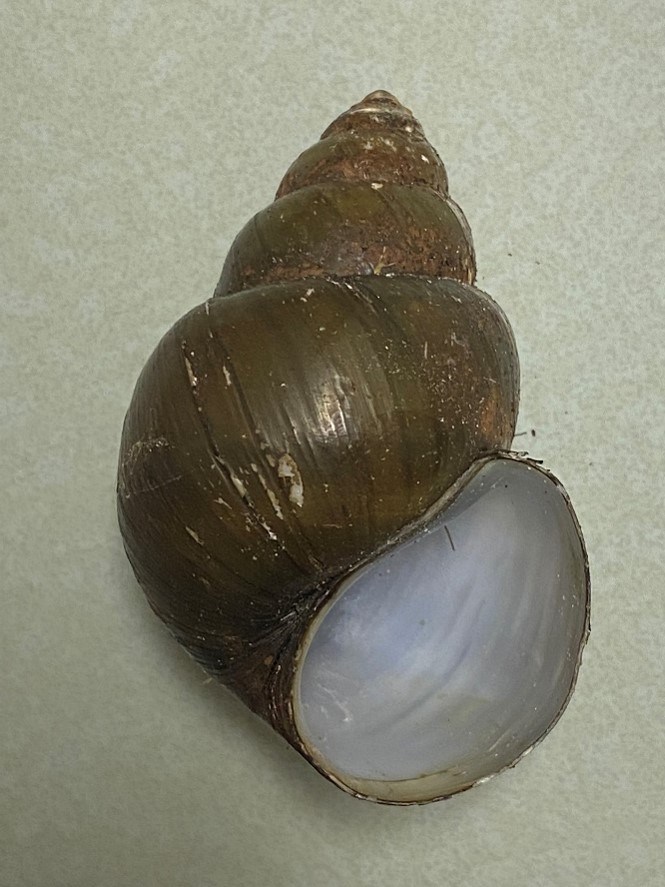 Chinese/Japanese Mystery Snails
Chinese/Japanese Mystery Snails
Chinese (Cipangopaludina chinensis) and Japanese (Cipangopaludina japonica) Mystery Snails both continue to be found in Georgia. The dark brown shells have several whorls and can reach sizes approaching two inches long. Japanese and Chinese mystery snails are a host for parasites, including rat lungworm and two human-intestinal trematides. Because of their potential to reach high densities when introduced, mystery snails may also outcompete native snails.Flathead Catfish
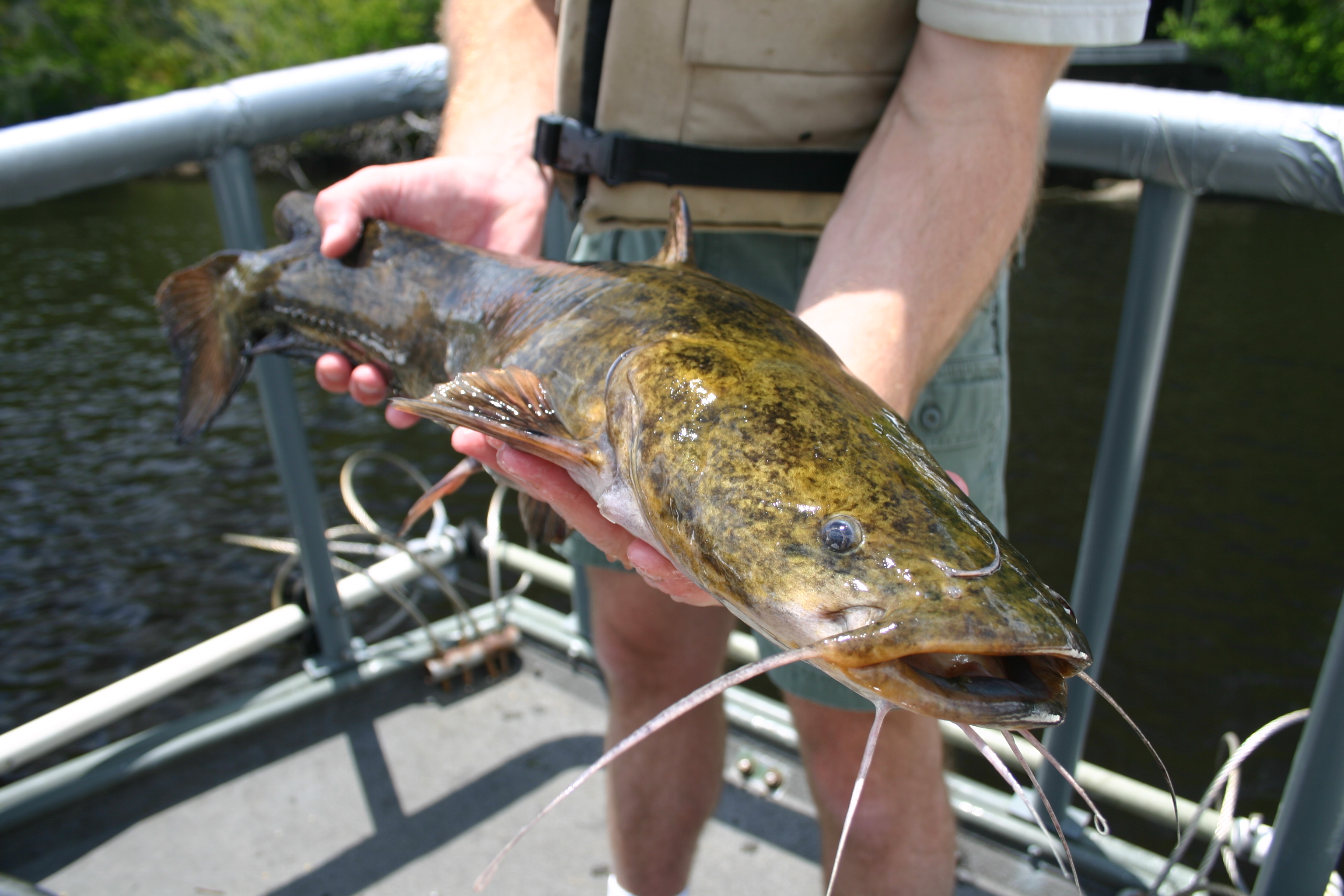
Native only to the Coosa River in Georgia, flathead catfish (Pylodictis olivaris) have decimated the popular redbreast sunfish and bullhead fisheries in the Altamaha River since their illegal introduction in the mid-1970s. In the mid-1990’s, the species was illegally introduced into the Satilla River, a river known historically for its redbreast sunfish fishery. Flatheads pose a direct threat to these and many other native panfish. Since 2007, GA WRD Fisheries staff have dedicated a significant amount of time to removing flathead catfish from the Satilla River to suppress the population and minimize its impacts on native fish populations.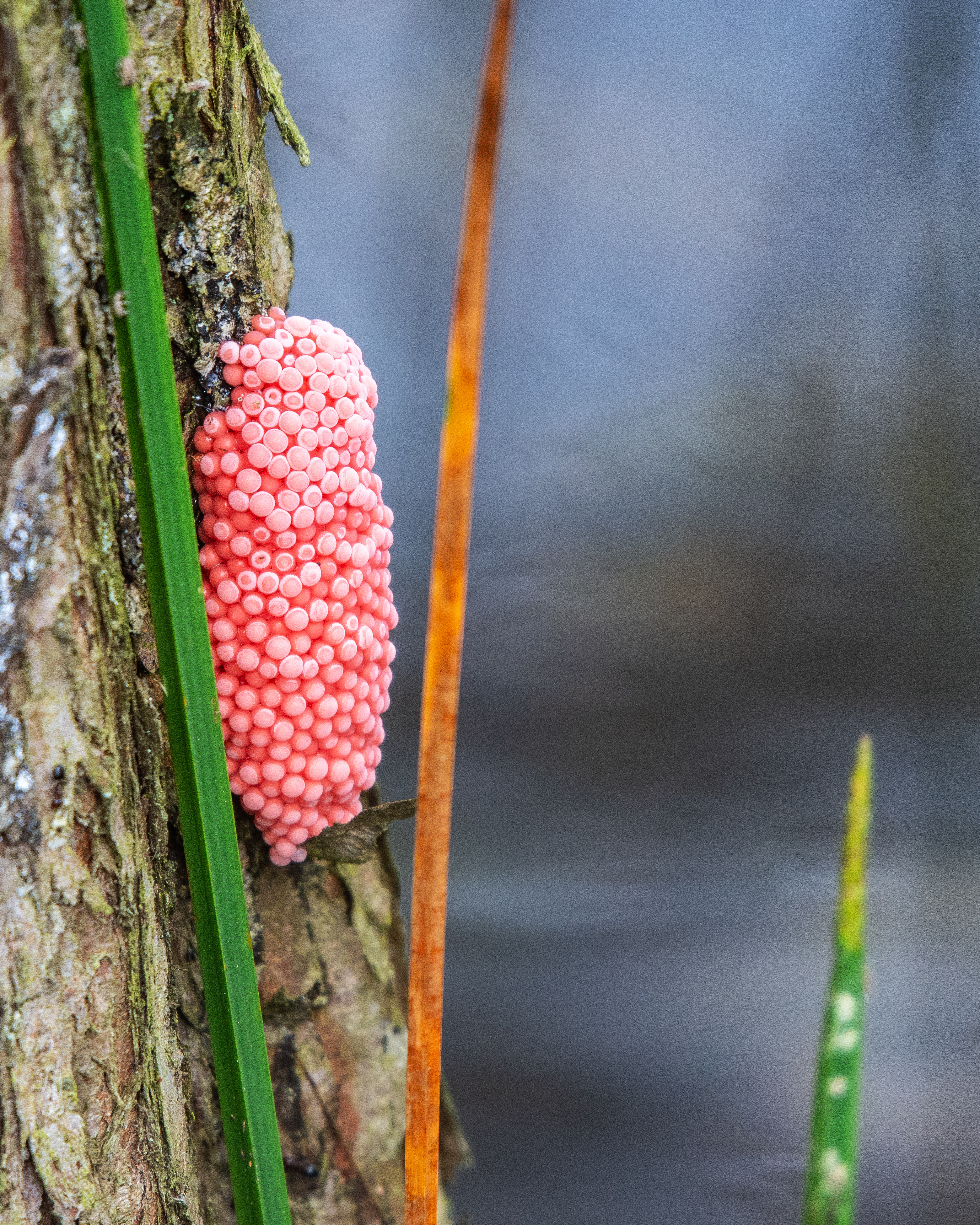 Island Apple Snail
Island Apple Snail
Island Apple Snails (Pomacea insularum) are originally native to South America. These invasive snails are the largest non-marine snail in the southeastern U.S. The shells can be near baseball-sized (100 mm or over 3 inches). The bright pink or red large egg masses are laid on vegetation or trees. Concerns exist that the species may outcompete native snails, and may be a host for parasites that could affect people (e.g. rat lung parasite).Lionfish
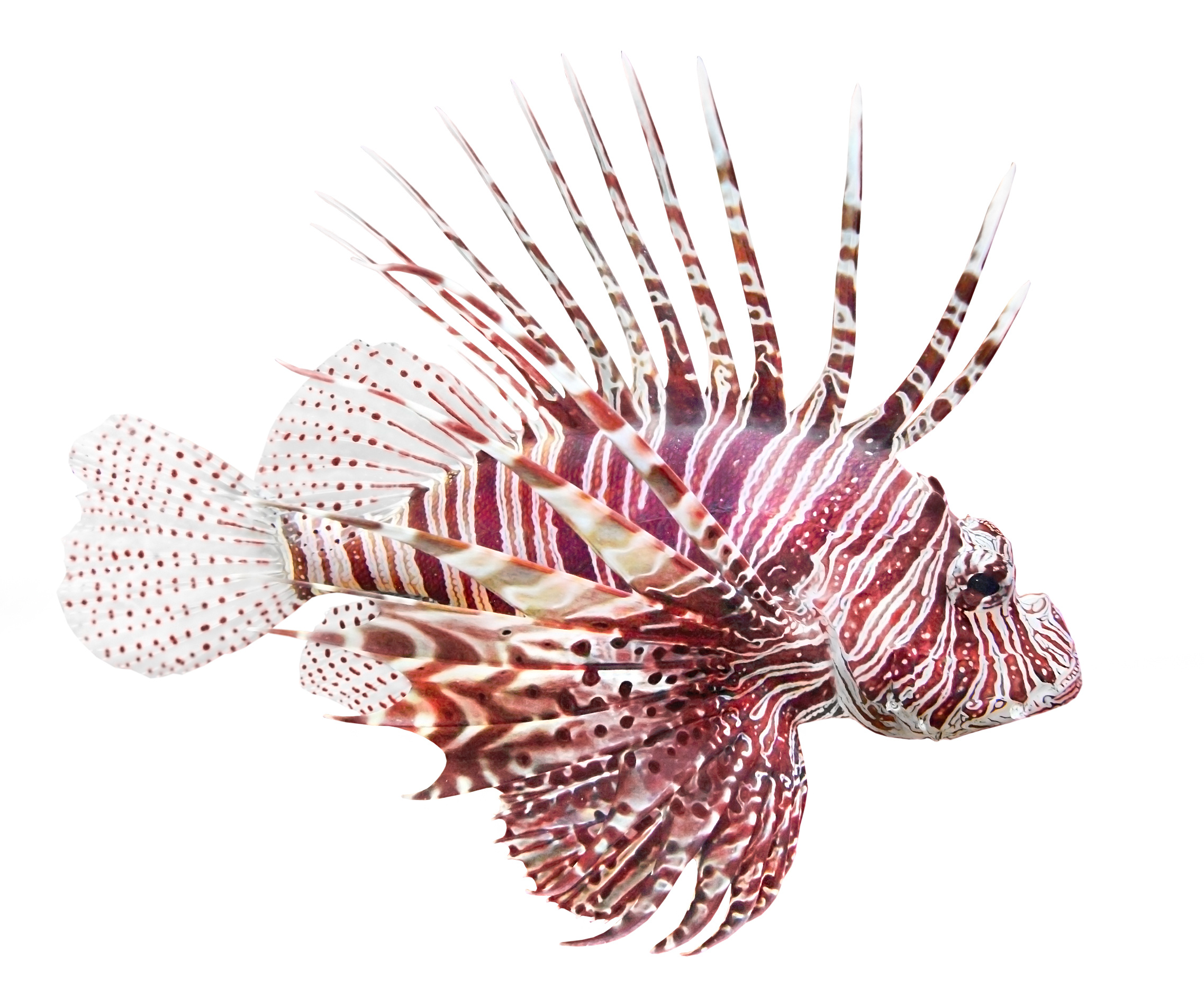
Since its first sighting in the Atlantic off the Florida coast in 1985, the northern expansion of the lionfish (Pterois miles) population has created much concern for fishery managers. A notorious top-level predator, lionfish are known to consume significant quantities of other reef fish, including prized grouper and snapper species. Such predation negatively impacts the quantity and characterization of these and other fish. Northern Snakehead
Northern Snakehead
In October 2019, the first confirmed northern snakehead in GA was captured and reported by an angler in Gwinnett County.These fish are native to China, Russia, and Korea. Northern snakeheads have been imported into several countries, including the USA, primarily for food purposes. An obligate air breather, the species can live out of water for hours and can travel short distances across the land. As an apex predator, the species has the potential to negatively impact native species in areas where it is introduced. In Georgia, it is unlawful to import, transport, sell, transfer, or possess any species of snakehead fish without a valid wild animal license. If you suspect you have found a snakehead, you are advised to take the following steps:- Determine if the fish is a native Bowfin (mudfish) or a similar looking fish to the snakehead - before reporting. If it does not appear to be a bowfin, do not release it.
- Retain the fish in a secure container.
- If possible, take pictures of the fish, including close-ups of its mouth, fins, and tail.
- Note where it was caught (waterbody, landmarks, or GPS coordinates).
- Immediately report it to the regional GA WRD Fisheries Office
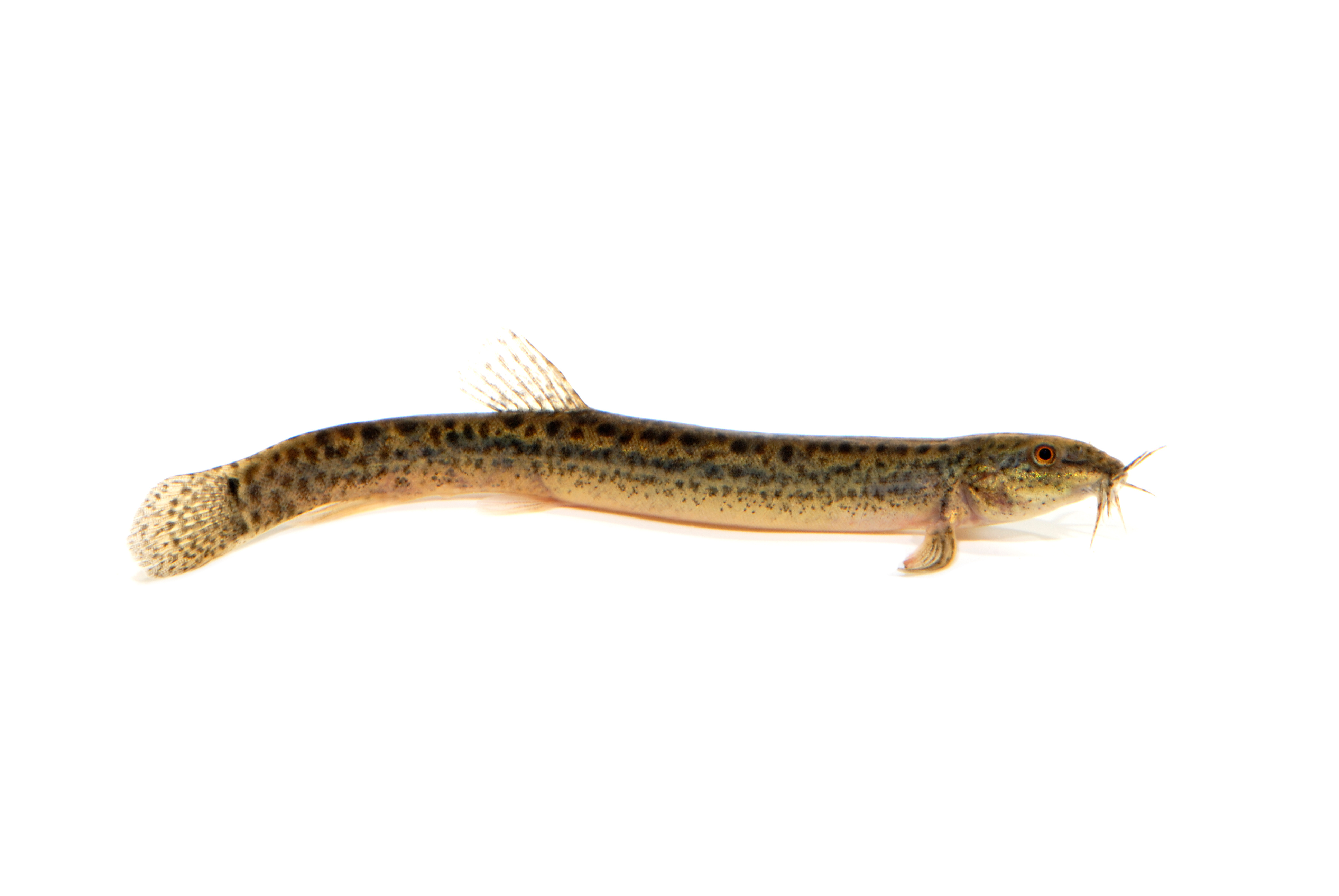 Oriental Weather Loach
Oriental Weather Loach
While sampling for Altamaha shiners in early November 2020, University of Georgia researchers were surprised to find several specimens of an unknown species in McNutt Creek, a tributary to the Middle Oconee River, near Athens. Close examination led them to identify the fish as an Oriental weather loach (Misgurnus anguillicaudatus), a common aquarium species native to Eurasia and north Africa that is sometimes used as bait but one that had never been reported in Georgia. Weather loaches may have been introduced by an aquarium owner who no longer wanted the fish and dumped them. This can have dramatically negative impacts on native species populations. Instead, contact the pet store where the animal was purchased to see if they will take it back. If not, please contact the regional GA WRD Fisheries Office for assistance.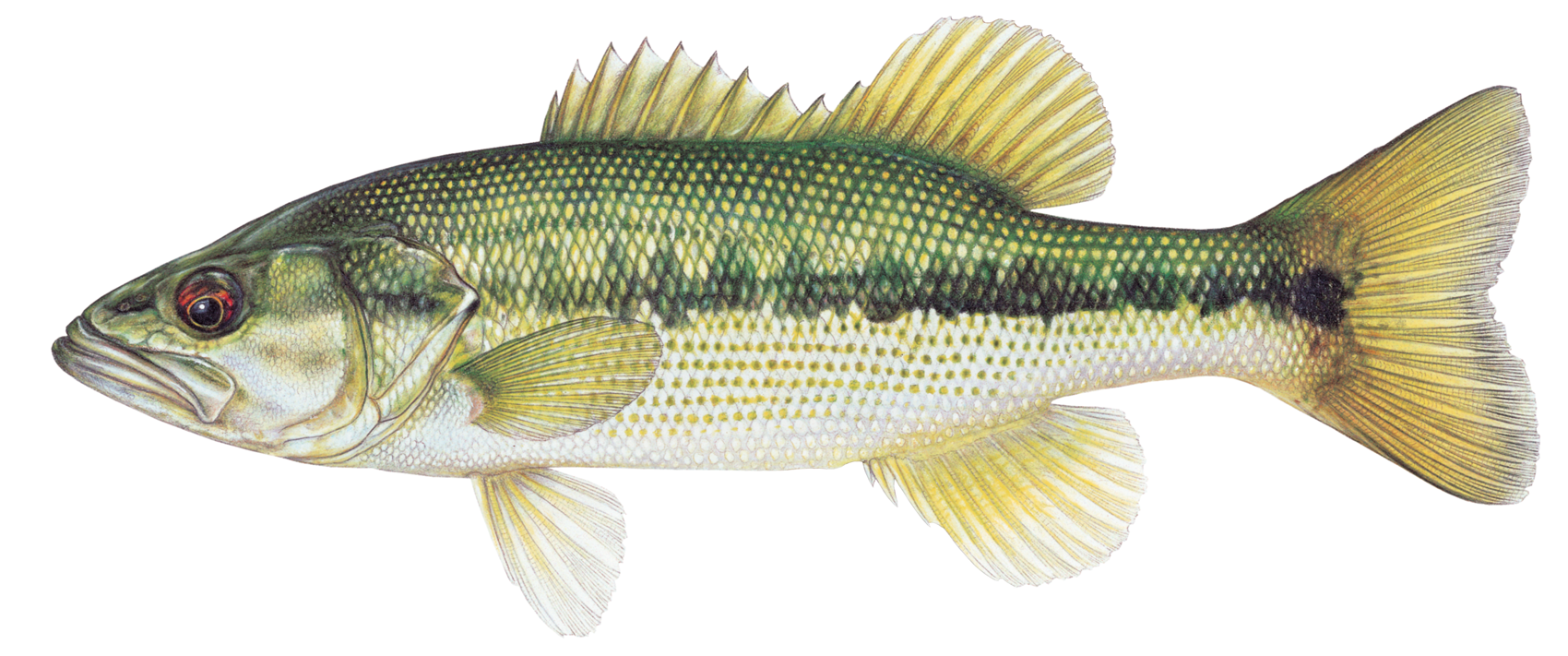 Spotted Bass
Spotted Bass
Spotted bass (Micropterus punctulatus), also known as Kentucky spotted bass, are native to the Mississippi River and Gulf drainages, including the Tennessee River and waters just inside the north Georgia border. While the species is not native to most of Georgia, it has been introduced into various waterbodies in Georgia in recent years. Negative implications include changing the dynamics of an ecosystem (lake, river) and affecting native bass populations through competition and crossbreeding.While spotted bass may seem desirable to some fishermen, they are not native to much of Georgia and can have negative impacts on other fish species. Anglers should not relocate or introduce these species into new areas.
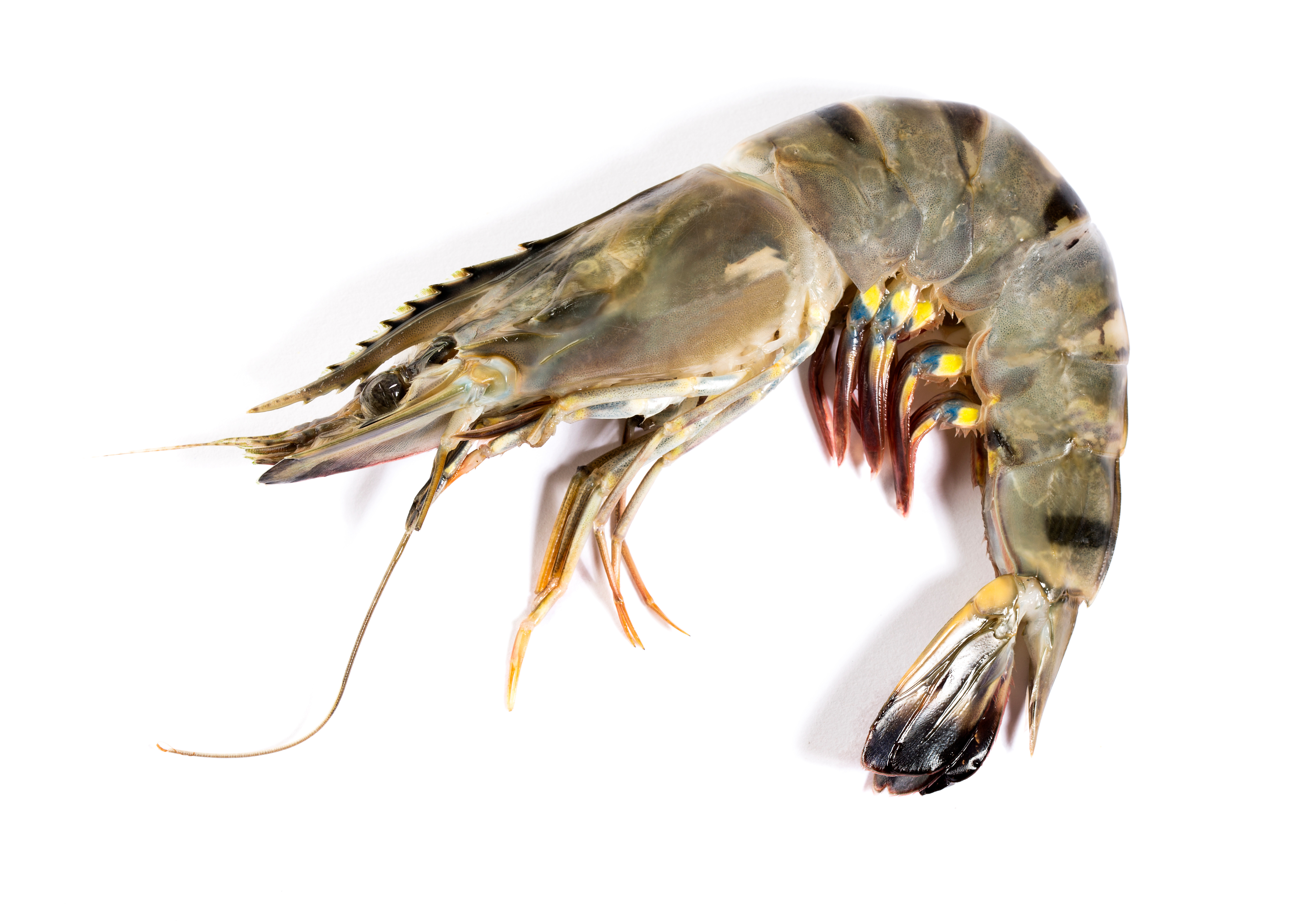 Tiger Shrimp
Tiger Shrimp
Native to Indo-Pacific, Asian, and Australian waters, Asian tiger shrimp (Penaeus monodon) are now found along the southeast and Gulf coasts of the United States, including Georgia. While small numbers of this non-native species have been reported in U.S. waters for over a decade, sightings have increased over the past few years. Tiger shrimp are one of the primary species raised in shrimp farms around the world and can grow to be three times the size of native shrimp and are of concern due to their potential to compete for food and habitat resources, prey on native shrimp, and potentially transmit disease to native shrimp populations.Various Aquarium Fish Species (Pacu, Tilapia, Oscar, Haplo, etc.)
Over the years, several species of aquarium fish have been found in private and public waters in Georgia. These introductions typically occur as a result of aquarium owners who no longer wish to keep these pets and release them into local waters. This can have dramatically negative impacts on native species populations. Instead, contact the pet store where the animal was purchased to see if they will take it back. If not, contact the regional GA WRD Fisheries Office for assistance. Yellow Bass
Yellow Bass
Yellow bass (Morone mississipiens) are native to the Mississippi and Tennessee River drainages, including some waters in the upper northwest corner of Georgia. This smaller Morone species has been introduced into other locales in Georgia, including the Coosa, Etowah and Oostanaula rivers, Rocky Mountain Public Fishing Area, and Carter’s Lake. In areas where it is not native, the species has the potential to compete with more desirable game fish. Adult size is relatively small compared to other Morone species, making them less desirable to some anglers. There is no size or creel limit on yellow bass, and anglers are encouraged to harvest the species.Zebra Mussel
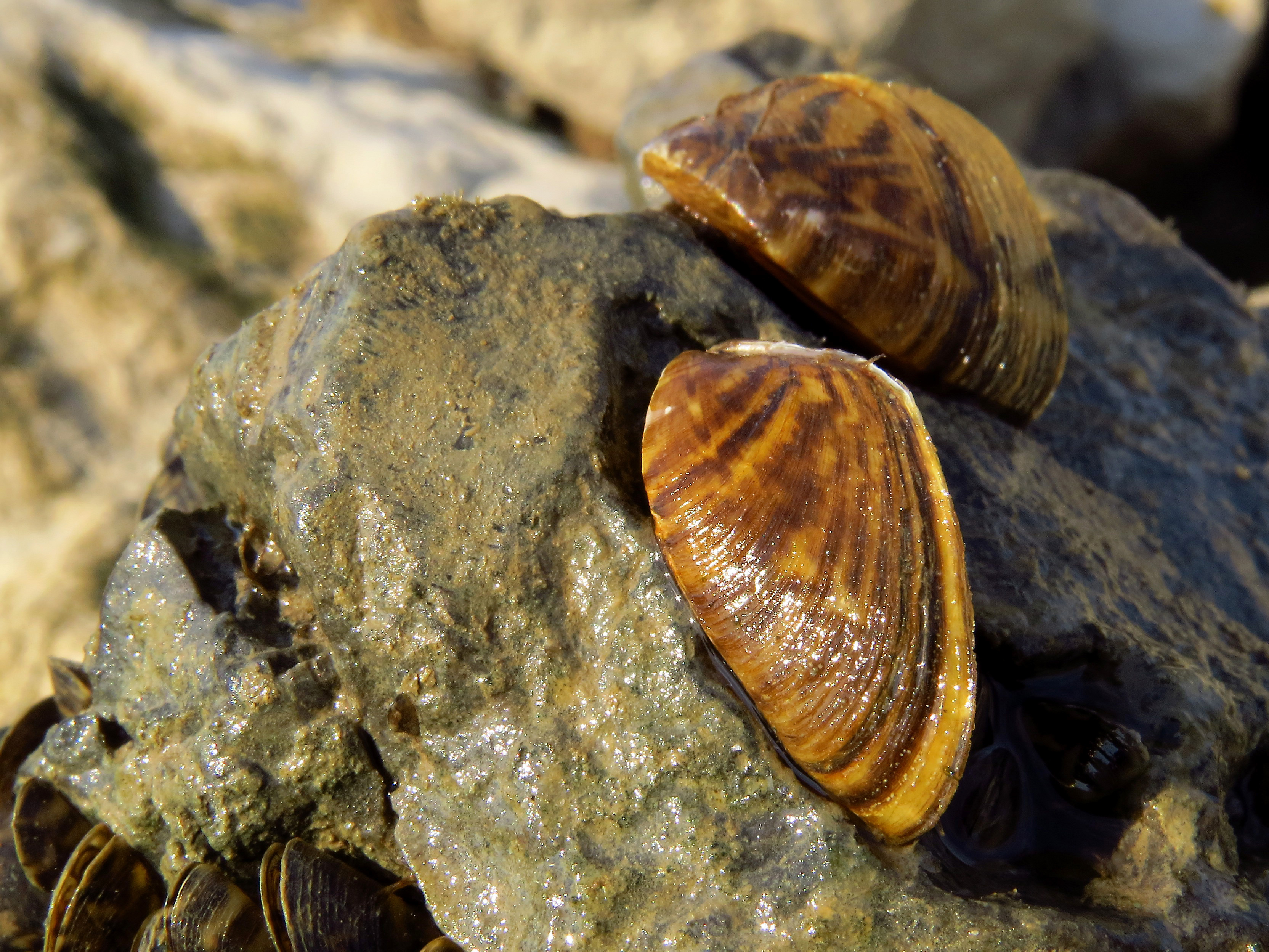
Native to Eurasia freshwaters, the zebra mussel (Dreissena polymorpha) was introduced in the Great Lakes in the mid-1980’s, likely via ballast water. Since then, the species has been moving south, and is now found in Tennessee and Alabama. Though not currently known to exist in Georgia, a recent incident in 2021 near Lake Lanier and the nationwide recall of infected aquarium products serves as a reminder that the threat is real.Distinguished by the striped pattern on its shell, zebra mussels are small in size (<2”) but potentially large in impact. The species has the potential to cause significant ecological (adversely impact Georgia's native mussels, many of which are endangered) and economical (completely clog intakes for drinking water, power plants and outboard motors, costing millions of dollars in damage, control, and abatement) impacts. Consequently, it is imperative boaters and other users visiting affected nearby states/areas take necessary precautions to prevent bringing them to Georgia. If you suspect you’ve found a zebra mussel, note where it was found (water body, GPS coordinates), retain it and immediately contact the regional GA WRD Fisheries Office.
Plant Species:
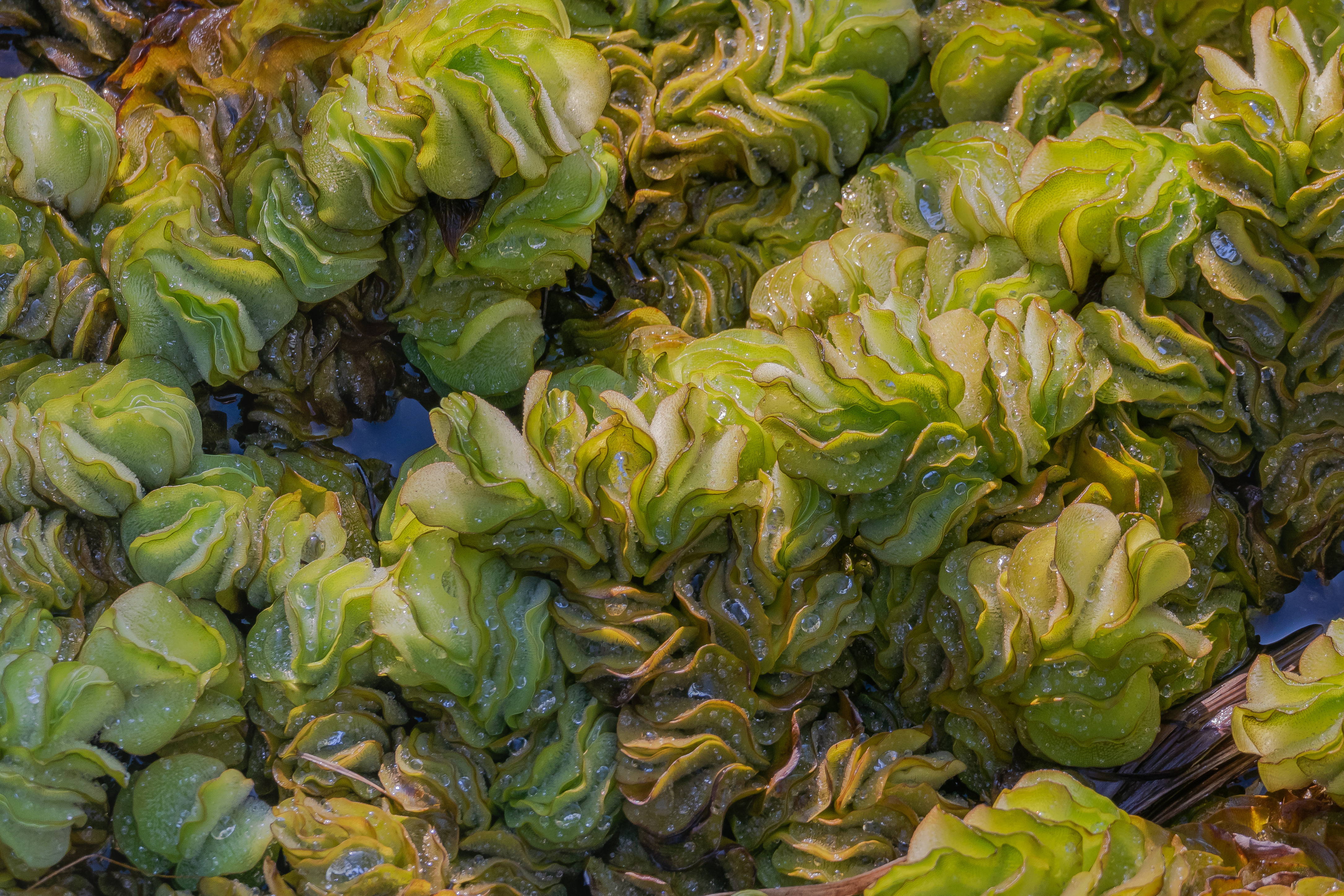 Giant Salvinia
Giant Salvinia
Giant Salvinia (Salvinia molesta) is one of the world’s most noxious aquatic weeds and is notorious for dominating slow-moving or quiet freshwaters. Found in Georgia since 1999, it grows rapidly and forms free-floating colonies that create thick mats, leading to oxygen depletion and absence of light for native vegetation. Sometimes confused with common salvinia, giant salvinia can be distinguished through examination of the stiff hairs on top of its leaf that branch into 4 parts which reconnect at the tip forming an “eggbeater” appearance (leaf hairs on common salvinia do not reconnect). Infestations can result in complete blockage of waterways, irrigation, and power generation intakes. Control of the species can be achieved through multiple avenues: Biological (Salvinia weevil- Cyrotobagus salviniae); Mechanical Removal; Water Level Drawdown; and Chemical (herbicides). If you suspect you have giant salvinia in your waterbody, immediately report it to the regional GA WRD Fisheries Office.Hydrilla
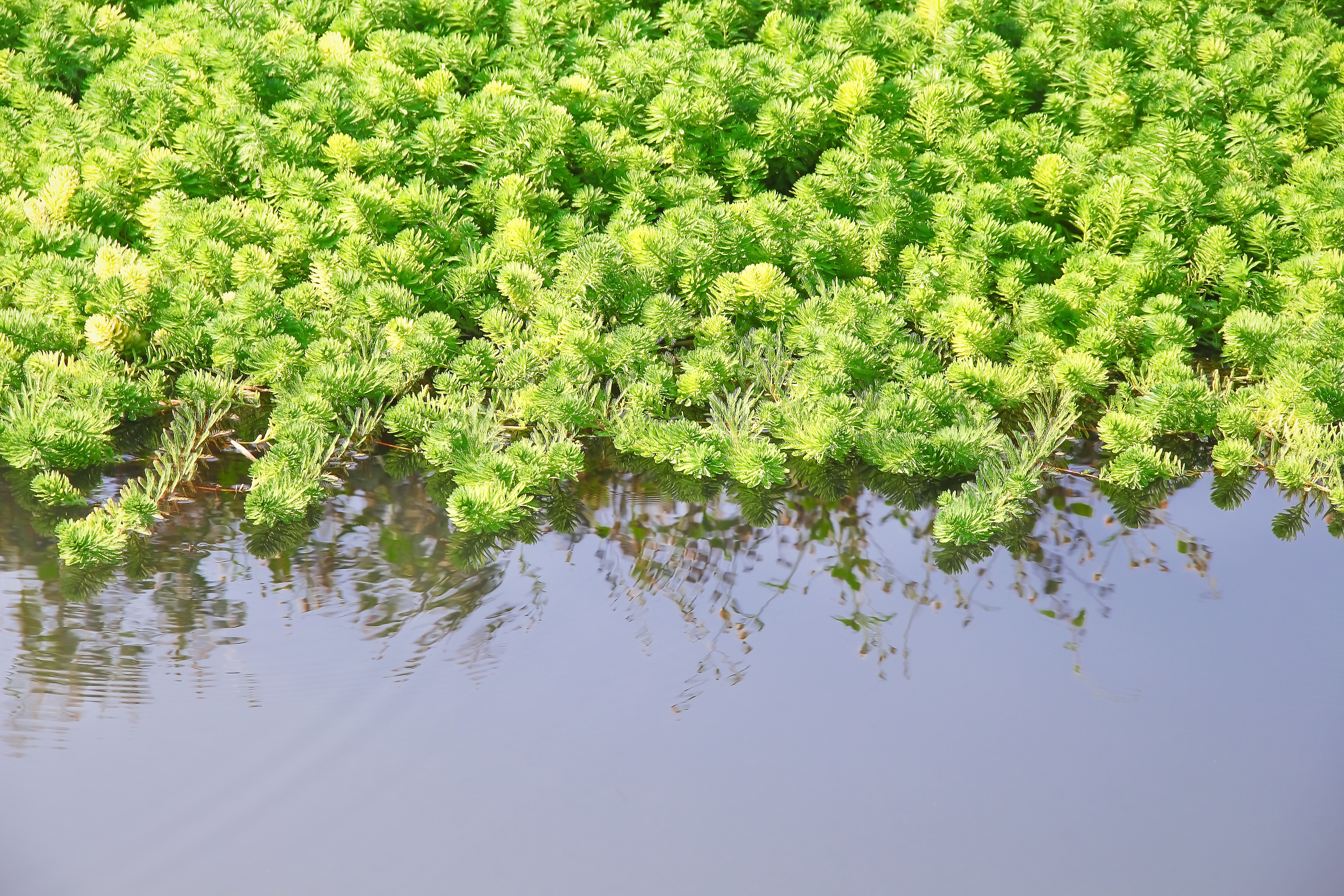
Hydrilla (Hydrilla verticillata) is an aquatic plant species native to Eurasia and believed to have been first introduced into the US in the 1960s. It is also known as Florida elodea, water thyme, water-thyme, and waterthyme. This plant is present in several Georgia waterbodies around the state. Recent research done investigates the potential links between hydrilla infestations and outbreaks of an often-fatal disease (Avian vacuolar myelinopathy) that can affect birds. Most recently, a link to hydrilla has been suspected in bald eagle deaths in the Southeastern US.Parasite/Disease Species
Rat Lungworm: Known to cause eosinophilic meningoencephalitis in humans, this invasive parasitic nematode (worm) has a complex life cycle involving multiple animal hosts, including rats and various mollusks (slugs/snails) like invasive Apple Snails. Rats transmit the larvae through their feces, which are then ingested by snails/slugs as they feed on the feces. Human infection can occur in multiple ways, primarily through consumption of raw or undercooked infected snails or potentially by eating unclean vegetables/plants contaminated with slugs or their slime. When accidentally ingested by a human, the parasite can go to the brain, spinal cord, or other organs and cause inflammation, nausea, vomiting, neck stiffness, headaches, and other neurological symptoms, potentially culminating in a coma and even death. As such, it is imperative to thoroughly cook any mollusks (apple snails, etc.) Prior to eating them, along with thoroughly wash any vegetables or plants you may wish to eat.
Whirling Disease: First detected in the U.S. in 1958 and first documented in Georgia in 2021, this disease is found in more than 20 states. Whirling disease can cause 90 percent or greater mortality of young rainbow trout and can have serious impacts to wild and hatchery trout populations. The disease is caused by the microscopic parasite Myxobolus cerebralis, which damages cartilage and skeletal tissue in trout causing diseased fish to swim in a "whirling" motion. While often fatal to juvenile trout, the disease (or consumption of infected trout) is not known to affect humans or pets.
Infectious hematopoietic necrosis virus (IHNV) is an infectious viral disease of salmon and trout. First recognized in the 1950’s, the disease can have significant economic and ecological impacts. Fry and small fingerlings are most susceptible, and mortality can be 100% in fry. Signs of the virus in affected fish may include darkened pigmentation, exophthalmia (eye bulging), fluid accumulation in the abdomen, trailing fecal casts, and small hemorrhages in the fins and body musculature.
Further testing could not confirm the presence of IHNV in hatchery-raised trout at the Buford and Summerville previously reported in 2021.
Didymo: This disease, also called rock snot, is a freshwater diatom that produces thick algae mats along stream bottoms. The mats can be so thick that they can alter stream habitats and make fishing difficult. Didymo can be spread easily from one water body to another. Recently found in North Carolina for the first time, this microscopic algae is considered a threat to Georgia streams and rivers.
Gill lice: These lice, a parasitic crustacean that attach to the gills of trout, recently were found in trout in North Carolina. In high concentrations, these lice can impact respiration and the health and survival of the trout.
Achtheres: A parasitic copepod that infects the gills of freshwater fish, especially striped bass, and is easily visible when it matures and moves into the fish’s mouth and gill arches. First documented in Tennessee, the parasite has been observed in several Georgia lakes. Though currently not believed to cause direct mortality, it is believed to cause some fish stress and, along with other factors, could impact fish health.
- How You Can Help
Georgia boaters and anglers can help prevent the movement of aquatic nuisance species through these simple actions:
Boaters
- Clean gear, watercraft, trailer, motor, and equipment. Remove visible aquatic plants, mussels, other animals, and mud before leaving any water access.
- Drain water from gear, boat, bilge, motor and livewell by removing drain plug and opening all water draining devices away from the boat ramp. Never empty your bait bucket into Georgia waters.
- Dry everything at least five (5) days before going to other waters and landings or spray/rinse recreation equipment with high pressure and/or hot water (120 degrees F/50 degrees C or higher).
Anglers
- Clean gear and recreation equipment. Remove visible aquatic plants, mussels, other animals, and mud before leaving any water access.
- Drain water from gear and equipment, but never empty your bait bucket into Georgia waters.
- Dry everything at least five (5) days before going to other waters and landings or spray/rinse recreation equipment with high pressure and/or hot water (120 degrees F/50 degrees C or higher).
Aquarium Pet Owner
If an aquarium owner finds themselves unable to care for an aquarium pet/animal/species, it is important to know what to do with them. It is NOT a good idea to take the fish or plant to a nearby waterbody and release it. This action can potentially have severe negative consequences on native species. Instead, contact the pet store where the animal was purchased to see if they will take it back. If not, contact the regional GA WRD Fisheries Office for assistance.
ANS Training Opportunities for Citizens
To promote ANS learning and how citizens can better prevent unwanted introductions, GA WRD offers training opportunities. In-person training sessions may be space-limited; so, confirm details and sign-up early. Typically, trainings target adults, although we encourage all ages to pursue training.
Questions on a specific training event? Click on the link and find contact information for GA WRD staff leading that event.
Watercraft Inspection Training (WIT): GA WRD partnered with the Pacific States Marine Fisheries Commission to offer an in-person training designed to teach participants about watercraft inspection and decontamination. This hands-on training provides participants with the opportunity to learn how to minimize the transport and accidental introduction of ANS, including zebra mussels, into new waterbodies, while also providing info on basic decontamination procedures.
Hazard Analysis And Critical Control Point (HACCP) Training: GA WRD partnered with the US Fish and Wildlife Service to offer an in-person training to educate scientists, marina owners, and other outdoor professionals on developing and applying HACCP plans to minimize the potential for moving or introducing Aquatic Invasive Species during field activities. A multitude of non-native plants, animals, and even diseases continue to be a threat to GA, and our best chance to minimize their impacts is to PREVENT their introduction.This training introduces participants to the HACCP process; provides better understanding to invasive species pathways; and teaches how to apply the 5-step HACCP process through developing unique plans specific to your job.
Upcoming Trainings
Hazard Analysis and Critical Control Point (HACCP) Training
We are excited to announce that a HACCP training class led by our partners at the USFWS will once again be offered on June 24-25, 2025 at Laura Walker State Park in Waycross. Register for the HACCP Training by May 1, 2025.Learn more by viewing the HACCP Training flyer.
Agency Partner ANS Trainings
Remember:
Never release live bait, aquarium fish, aquatic plants or mussels into Georgia waters, and properly dispose of bait. For more information on disposing of unwanted fish, plants, or other biota, contact your regional Georgia DNR Wildlife Resources Division Fisheries Office.
ONLY GA DNR staff is authorized to stock or move live fish or aquatic plants from one body of water to another.
- Georgia Efforts to Combat ANS
Georgia is working to educate and inform citizens of the threat of Aquatic Nuisance Species (ANS) and how we can best combat them in multiple ways. Efforts include the development and implementation of management plans and projects, partnerships with other agencies, and ongoing education and outreach materials and events.
Plans and Projects:
- ANS Laws, Rules, and Regulations
Legislative authority for the management of Game and Fish within Georgia is governed by the Georgia General Assembly and is outlined in the Official Code of Georgia Annotated (OCGA), Title 27. OCGA 27-1-4 provides authority for the “promulgation of rules and regulations to protect wildlife, the public, and natural resources of this state” to the Board of Natural Resources (Board Rule). The governance and management of ANS within Georgia includes both legislative and regulatory processes.
Laws, Rules, & Regulations Pertaining to Aquatic Nuisance Species (ANS) seeks to highlight legislation (laws), rules, and regulations that specifically impact ANS management in Georgia. Additional information on all laws, rules, and regulations, along with specific permits needed for the possession of certain wild animals, including ANS, can be obtained from your nearest Law Enforcement Office.
- ANS Partners
- ANS Education and Outreach
Each year, GA WRD staff speak to hundreds of kids at various schools in our state. These events provide an excellent opportunity for students, teachers, and parents to hear about invasive species issues in our state, learn about many of our native species, and discover how they can help prevent future introductions of non-native and potentially harmful species. If you are interested in having someone speak to your school or civic group about native or non-native species in Georgia, please contact the Aquatic Nuisance Species Coordinator at ANSInvasives@dnr.ga.gov.





